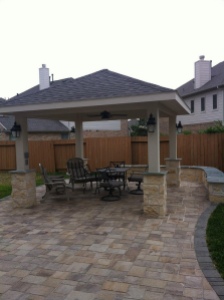The 11 Most Popular Flooring Options for Your Outdoor Space
April 15, 2013 Patio DesignQuick: Close your eyes and picture yourself standing on the perfect patio. What’s under your feet? Flagstone? Travertine? According to Texas Custom Patios, there are 11 flooring options that account for more than 99% of the patios, gazebos and decks they create. Which one did you choose?
Concrete is one of the most durable building materials available. Concrete is often used as a base for materials like tile, but it can serve as a stand-alone option as well. Concrete is long-lasting, inexpensive and easy to maintain. However, if it does crack, it’s difficult repair.
Today’s concrete flooring can be stained or pigmented to accentuate your décor. You can even surface-coat your concrete floor with paint.
Stamped concrete adds embellishments such as pattern or texture to regular concrete. Stamping can replicate stone, slate, bricks, flagstones, or even wood by imprinting patterns in freshly poured concrete. Stamped concrete can offer the authentic look of these materials – with the added benefits of an economical price, faster installation, and permanent durability.
Cool decking helps keep your outdoor floor cool, so your bare feet don’t burn on the way to the pool. Kook Deck technology, invented in 1962, lowers the surface temperature of concrete and withstands a good deal of thermal expansion and contraction. Cleaning and maintenance is easy, but Kook Deck tends to fade in the sun over time, making patch jobs tricky to match. Acrylic, or polymer modified cement, has become a popular alternative to Kool Deck because of its ease of use, stain resistance, and customizability. While Kool Deck must be applied to freshly poured concrete to bond properly, acrylic can be used on old concrete as well – but it costs twice as much and doesn’t cool as well.
Slate is an eye-catching and strong stone flooring. It’s easy to maintain and comes in a range of earth tones from grey to terra cotta. Installing a slate floor will require a level surface, with an underlayer of compacted sand and/or gravel. Slate’s natural texture can become slick when wet.
Brick flooring is relatively low-maintenance, although be attuned to the ground shifting over time, as your brick floor could become an irregular surface.
Wood decking offers easy installation, but the wood itself requires a thorough cleaning and resealing every couple years to maintain its beauty. Douglas fir has been highlighted as a particularly sound choice of species for its stability and lack of knots. Another popular wood, Ipe is a Brazilian hardwood known for its beauty and durability. Using a local hardwood like Texas red oak can make the project more economical.
Composite decking is great if you like the look of wood, but want to cut down on maintenance. Composite decking materials mimic the look of natural wood. This combination of wood and plastic does not absorb as much water – which helps keep the material strong (but can trap moisture and cause decay to the wood joists underneath). Composite decking can be more expensive than natural wood and cannot be resurfaced when scratched.








